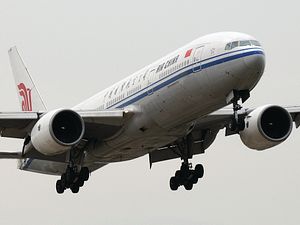On September 23, Hainan Airlines Flight HU7937 touched down in Prague’s Vaclav Havel Airport, marking the first-ever nonstop service between China and the Czech Republic, and adding yet another stepping stone to China’s “Air Silk Road.” In a statement during the opening ceremonies in the Czech capital, Hainan Airlines President Xie Haoming expressed his bright hopes for future cooperation: “With the implementation of China’s One Belt, One Road strategy, cooperation between Chinese and European aviation markets will further expand, creating many opportunities for business travel and outbound tourism between China and European countries.”
While the infrastructural development of President Xi Jinping’s One Belt One Road (OBOR) initiative has so far largely focused on improving rail and maritime links, aviation is gradually entering the picture. Of the 193 Chinese civil aviation construction projects planned for 2015, 51 strategic projects, totalling US$32 billion, directly serve the OBOR initiative. Over the past two years, China has constructed 15 new airports and expanded 28 existing ones that have direct links with countries connecting China with Europe via Central Asia.
Aviation is set to play an increasingly large role in China’s commitment to strengthen the economic capacity and “connectivity” among the nations within the OBOR area. During the 2015 China Civil Aviation Development Forum held in June, Civil Aviation Administration of China (CAAC) chief Li Jiaxiang noted that infrastructure development around airports is cheaper than road and rail constructions and could accelerate trade between China and the countries along the Silk Road. Moreover, with many of the countries along the Belt and Road closed off by deserts and mountains, air transportation is often the most cost-efficient option.
Civil aviation investment will likely form a part of China’s 13th Five Year Plan, which is set to be drafted from October 26-29 in a key plenum in Beijing. In anticipation of this, the CAAC has pledged to further open the country’s airspace to carriers from South and Central Asia and to allow for more direct air links, a move that would provide a much-needed boost to China’s state-run airline carriers. Earlier this year the CAAC, which functions under the Chinese Ministry of Transport, encouraged Chinese airlines to step up their “going out” efforts and develop large aviation corporations with vast networks and robust international competitiveness.
Plans have also been approved for a second airport in Chengdu, which will make the provincial capital only the third city in mainland China to have a second airport, after Shanghai and Beijing. Chengdu, geographically closer to Europe than other major cities in China, will contribute to expansion efforts to Europe, which has so far been slow in responding to China’s enthusiasm for the Silk Road.
The vigorous investment in air infrastructure may, however, degenerate into white elephant projects, as media commentators have pointed out. China’s interest in most of the Silk Road economies centers on gaining access to oil and gas reserves, which do not form sources of traditional cargo. It also remains uncertain whether Chinese tourists would be attracted to Central Asia, known in China for its cold winters and weak tourism infrastructure.
But while Central Asia may not be a hotspot for Chinese tourists, Europe offers an attractive vacation spot for many. Despite the initial lackluster response from the EU, the recent proliferation of European think tank attention on the OBOR suggests that Europe is finally waking up to the benefits a cooperative approach can bring.
China, at the end of the day, shows no signs of abating its efforts in infrastructural investment, even amid concerns over the risks they may provide to its domestic infrastructure. With aviation infrastructure cheaper, safer, and more environmentally-friendly than roads and railways, the aviation industry seems poised to take Xi’s Silk Road to new heights.

































